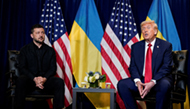Seeking Out One Bold Stroke to Save the Banks
Wasn’t it just four months ago that the United States government was racing to save the American International Group, forcing the sale of weak banks and writing huge checks to stabilize the teetering banking system- The worst was over - or so we were given to believe.
It hasn’t worked out that way. In November, not long after it was handed $25 billion in new capital, Citigroup was back for more - another $20 billion in bailout money and a government backstop of more than $300 billion in potential losses. Recently, it was Bank of America’s turn. It came back because of the huge write-down of its shiny new toy, Merrill Lynch. It got another $20 billion and a backstop against losses of $118 billion in troubled assets.
When is it going to end- Because of declining asset values, the original bailout money has largely disappeared. “It’s like putting money in a pothole that keeps getting bigger,” said Daniel Alpert, the managing partner at Westwood Capital, which has offices in New York and Hong Kong. And it’s not over yet. Goldman Sachs says the world banking system has absorbed about $1 trillion in losses - but there is likely to be another $1.1 trillion yet to go. In past financial crises, it has often been the bold and brilliant stroke that has restored confidence and revived the financial system. During the German hyperinflation of the 1920s, the government actually created a new currency. During the Latin American crisis of the late 1980s, the United States government created so-called Brady bonds, which cleverly allowed banks to get their Latin American debt off their balance sheets by turning it into tradable instruments.
And here we are again, in need of bold action and strategic thinking and the restoration of confidence.
The response has got to stop being so haphazard. Think about it: Citigroup is slimming down.
Bank of America is bulking up. The government is essentially backing both approaches. It makes no sense.
I started wondering if there is a better approach. Perhaps this new idea being discussed in Washington of creating a government bank to buy up toxic assets might do the trick. It turns out I’m not the only one who’s been asking this question lately.
“I don’t want to have to do any more of these one-offs,” said Sheila C. Bair, the chairwoman of the Federal Deposit Insurance Corporation .“Nobody does.” She was referring to the Bank of America deal . But she could just as well have been talking about the Bush administration’s entire approach to the financial crisis.
Last September were the Fannie Mae and Freddie Mac takeovers, the Merrill Lynch sale to Bank of America and then the disastrous Leh man Brothers bankruptcy. After the A.I.G. rescue, Ben S. Bernanke, chairman of the Federal Reserve, and Treasury Secretary Henry M.
Paulson Jr. concluded that they needed to find a systemic approach to fixing the huge problems in the banking system. They came up with the $700 billion bailout bill.
The government was going to use funds from the Troubled Asset Relief Program to buy up bad assets from banks and other institutions . But two things had become clear. The first was that nobody had a good idea of how to value the toxic assets the government was proposing to buy. And second, the banking system had deteriorated so badly that most of that first $350 billion had to be shoveled into it as recapitalizations.
That initial recapitalization was necessary. Without it, many more banks would have been insolvent, or would have been hoarding capital, fearing future asset write-downs. But the underlying problem has never gone away. The toxic assets are still on the books. Banks still don’t really know what they are worth, so they continue to be written down in piecemeal fashion.
The key point here is that any systemic solution has to deal with the bad assets . They need to be properly valued and isolated.
The second point is that the next round of recapitalization needs to encompass the entire banking system, and needs to be enormous.
Ms. Bair, Mr. Bernanke and Treasury officials have begun talking about a new kind of bank, one that would be created and capitalized by the government, and whose sole purpose would be to buy up bad assets and warehouse them in one place.
“You would have to mark the assets at the price they were selling for,” Ms. Bair said. “I think that is an advantage.” At long last, there would be some certainty. Private capital won’t return to the banking system until that happens.
“The only rub in the ointment is back to the original problem: How do you determine the market price-” said Josh Rosner, a managing director of the research firm Graham Fisher.
Senator Charles E. Schumer also worries about the total cost.“I’m hearing $1 trillion,” he told me.“That seems low.”But, he added, “if they can adequately answer that question, the idea has a lot of appeal, both on Capitol Hill and, I think, in the financial markets.
스마터리빙
more [ 건강]
[ 건강]이제 혈관 건강도 챙기자!
[현대해운]우리 눈에 보이지 않기 때문에 혈관 건강을 챙기는 것은 결코 쉽지 않은데요. 여러분은 혈관 건강을 유지하기 위해 어떤 노력을 하시나요?
 [ 건강]
[ 건강]내 몸이 건강해지는 과일궁합
 [ 라이프]
[ 라이프]벌레야 물럿거라! 천연 해충제 만들기
 [ 건강]
[ 건강]혈압 낮추는데 좋은 식품
[현대해운]혈관 건강은 주로 노화가 진행되면서 지켜야 할 문제라고 인식되어 왔습니다. 최근 생활 패턴과 식생활의 변화로 혈관의 노화 진행이 빨라지고
사람·사람들
more많이 본 기사
- 특검, 尹에 징역 10년 구형… “법치주의·사법질서 파괴”
- 韓정부, 노란봉투법 해석 지침 공개… 하청 임금·근로조건 좌우하면 ‘진짜 사장’
- ‘서해 공무원 피격 은폐’ 혐의 서훈·박지원 등 1심 모두 무죄
- ‘정보 유출자 셀프 조사’ 경찰에 늦게 알린 쿠팡… 증거인멸 의혹
- 한파에 고드름이 주렁주렁… 서울 이번 겨울 첫 한파주의보
- 트럼프 “소말릴란드 아는 사람 있나?”…이스라엘 승인에 ‘NO’
- 황하나, 마약 도피 중 캄보디아서 출산.. “아이 양육” 호소에도 구속
- “아동 수출국 오명 벗는다” 70년 만에 해외입양 중단
- “올해 최고 주목받은 테크 거물은 머스크 아닌 래리 엘리슨”
- 찰스 3세, 내년 방미 추진…트럼프에 英왕실 ‘매력 공세’될까
- 소싯적 ‘치기어린’ 주소 “굿바이”…지메일 주소변경기능 도입
- ‘김건희에 로저비비에 선물’ 김기현 부인 특검 재출석…곧 기소
- LA 등 서부에 사흘째 폭우…동부엔 폭설 예보
- “영원한 생명 주실 승리의 하느님 오신 날”
- 쏟아지는 갑질·특혜 의혹… 버티는 김병기, 속 끓는 정청래
- ‘패션왕’ 뷔의 45가지 특별한 순간...日하퍼스바자 생일 특집 컬렉션
- 기이한 재력 과시 ‘가난 밈’ 확산에..신화 김동완 “이게 농담이라고?” 뿔났다
- 트럼프 압박에 굴복 UVA 총장 선출 강행
- 특검, 김건희 ‘금품 수수’ 무더기 기소… 뇌물 여부는 경찰 몫으로
- “새해 1호 법안은 2차특검” 정청래, 강경 기조 그대로
- 이혁재가 또.. “빌려간 3억원 안 갚아” 사기 혐의로 피소
- ‘서지승♥’ 이시언, 마흔 넷에 아빠 된다..2세는 아들 ‘암시’
- 與 ‘통일교·신천지 특검법’ 발의… 野 “뜬금없다”
- 김정은, 핵잠 이어 미사일 공장도 시찰
- [이지 사이언스] “온난화 막으려면 세계인구 44% 식단 바꿔야…문제는 소고기”
- “엔비디아, AI칩 스타트업 인수 아닌 기술 계약으로 규제 회피”
- 곽튜브, 재산 100억설에 입 열었다.. “얼마 안 남은 듯”
- 러, 트럼프-젤렌스키 종전회담 직전 키이우 대규모 공습
- ‘역대 최연소’ 백악관 대변인 레빗, 둘째 임신 공개
- 곽도원, 음주운전 3년 만 복귀각..스토리제이컴퍼니 측 “미팅 했지만 계약 단계 아냐”
- 미국, 美방산기업 제재한 中에 “대만 무기판매 보복 강력반대”
- 작년 운용자산 5조5천억달러…갑부들의 ‘패밀리오피스’ 월가 새 강자로
- 마이큐♥김나영, 제주로 떠났다..행복한 네 가족
- “출생시민권은 사기”⋯ 이민 2세대 공격 초점 맞춘 트럼프
- ‘NCT 탈퇴’ 태일, 성폭행 혐의로 결국 감옥行..징역 3년 6개월 확정
- ‘손흥민 감격의 첫 우승’ 올해 축구계 기적 톱8 선정 ‘선수로는 유일’
- 대만이슈 돌출로 美中 ‘삐걱’…내년 4월 트럼프 방중前 기싸움?
- 루비오 국무장관, 트럼프가 민 온두라스 당선인과 통화… “명확한 승리”
- VA·MD 7명 생굴 먹고 식중독…22개주 60여명 감염
- 16세로 성장한 버클리 문학, 성대한 송년 파티
- 위성락, 유엔 사무총장에게 방북 요청한듯…대통령실 “확인 어렵다”
- 통일교 ‘키맨’ 윤영호·송광석 재조사… ‘공소시효 난제’ 풀까
- ICE 버지니아 구금시설 ‘포화’…수감자 역대최고
- ‘마약 혐의’ 남양유업 3세 황하나 구속… “증거인멸 우려”
- 효연, 소녀시대 수입 서열 공개 “1위 나 아냐..윤아·태연이 더 벌어”
- 트럼프 관세에…고급 와인 시장도 ‘휘청’
- 8시즌 뛰고 ML 역대 17위 “오타니 GOAT 될 것”, ML 역대 50인 선정
- 린다 한 “내년 1월17일 별도 한인회연합회 만들겠다”
- 트럼프, 종전안 들고오는 젤렌스키에 “내승인前엔 아무것도 없다”
- 쿠팡, 자체 조사결과 발표후 첫거래일 급등…뉴욕증시서 6%↑
1/5지식톡

-
 미 육군 사관학교 West Poin…
0
미 육군 사관학교 West Poin…
0https://youtu.be/SxD8cEhNV6Q연락처:wpkapca@gmail.comJohn Choi: 714-716-6414West Point 합격증을 받으셨나요?미 육군사관학교 West Point 학부모 모…
-
 ☝️해외에서도 가능한 한국어 선생님…
0
☝️해외에서도 가능한 한국어 선생님…
0이 영상 하나면 충분합니다!♥️상담신청문의♥️☝️ 문의 폭주로 '선착순 상담'만 진행합니다.☎️ : 02-6213-9094✨카카오톡ID : @GOODEDU77 (@골뱅이 꼭 붙여주셔야합니다…
-
 테슬라 자동차 시트커버 장착
0
테슬라 자동차 시트커버 장착
0테슬라 시트커버, 사놓고 아직 못 씌우셨죠?장착이 생각보다 쉽지 않습니다.20년 경력 전문가에게 맡기세요 — 깔끔하고 딱 맞게 장착해드립니다!장착비용:앞좌석: $40뒷좌석: $60앞·뒷좌석 …
-
 식당용 부탄가스
0
식당용 부탄가스
0식당용 부탄가스 홀세일 합니다 로스앤젤레스 다운타운 픽업 가능 안녕 하세요?강아지 & 고양이 모든 애완동물 / 반려동물 식품 & 모든 애완동물/반려동물 관련 제품들 전문적으로 홀세일/취급하는 회사 입니다 100% …
-
 ACSL 국제 컴퓨터 과학 대회, …
0
ACSL 국제 컴퓨터 과학 대회, …
0웹사이트 : www.eduspot.co.kr 카카오톡 상담하기 : https://pf.kakao.com/_BEQWxb블로그 : https://blog.naver.com/eduspotmain안녕하세요, 에듀스팟입니다…
케이타운 1번가
오피니언

새해 더 중요해지는 노동법 준수

연말연시, 안전하고 차분하게
 캐슬린 파커 워싱턴포스트 칼럼니스트
캐슬린 파커 워싱턴포스트 칼럼니스트 [캐슬린 파커 칼럼] 지미 라이의 마지막 희망
 유경재 나성북부교회 담임목사
유경재 나성북부교회 담임목사 [한국춘추] 미국의 힘
 전병두 서북미수필가협회 회원
전병두 서북미수필가협회 회원 [금요단상] 비자 발급
 박일근 / 한국일보 수석논설위원
박일근 / 한국일보 수석논설위원 [지평선] 스님의 주례사
 신상철 / 고려대 고고미술사학과 교수
신상철 / 고려대 고고미술사학과 교수 [미술 다시보기] 신의 모습을 닮고자 한 예술가
 스티브 강 전 한인민주당협회 회장
스티브 강 전 한인민주당협회 회장 [스티브 강 ‘인사이드 미국’] 2026 중간선거: 트럼프 지지율 하락이 말해주는 것
 김홍일 케이유니콘인베스트먼트 대표
김홍일 케이유니콘인베스트먼트 대표 [기고] 안정의 기준은 어떻게 제도가 되었나
1/3지사별 뉴스

물류거점창고에 불체자 8만명 수용 추진
도널드 트럼프 행정부가 이민자 구금·추방을 효율화하기 위해 전국 물류거점 창고에 8만명 규모의 수용시설 확보를 추진한다고 24일 워싱턴 포스트…
‘학자금 상환’ 안하면 임금압류

“온 세상에 희망·평화의 빛 스며들길”
가자지구와 우크라이나에서의 전쟁, 고립과 불평등으로 세상이 어지러운 가운데 워싱턴 지역 각급 한인교회와 성당들이 성탄절을 맞아 일제히 예배와 …
“연말은 스트레스·새해 결심은 없다”

‘손흥민 vs 메시’ 2026 MLS 개막전서 세기의 맞대결 예고
LA 풋볼클럽(LAFC)가 2026시즌 MLS 정규리그 일정을 공식 발표하며 한인 축구 팬들의 시선을 한몸에 받고 있다. LAFC는 오는 20…
[새해부터 이렇게 달라진다] 최저임금 또 오르고… 유급 병가는 더 확대

오늘 하루 이 창 열지 않음 닫기 





















































.png)


댓글 안에 당신의 성숙함도 담아 주세요.
'오늘의 한마디'는 기사에 대하여 자신의 생각을 말하고 남의 생각을 들으며 서로 다양한 의견을 나누는 공간입니다. 그러나 간혹 불건전한 내용을 올리시는 분들이 계셔서 건전한 인터넷문화 정착을 위해 아래와 같은 운영원칙을 적용합니다.
자체 모니터링을 통해 아래에 해당하는 내용이 포함된 댓글이 발견되면 예고없이 삭제 조치를 하겠습니다.
불건전한 댓글을 올리거나, 이름에 비속어 및 상대방의 불쾌감을 주는 단어를 사용, 유명인 또는 특정 일반인을 사칭하는 경우 이용에 대한 차단 제재를 받을 수 있습니다. 차단될 경우, 일주일간 댓글을 달수 없게 됩니다.
명예훼손, 개인정보 유출, 욕설 등 법률에 위반되는 댓글은 관계 법령에 의거 민형사상 처벌을 받을 수 있으니 이용에 주의를 부탁드립니다.
Close
x